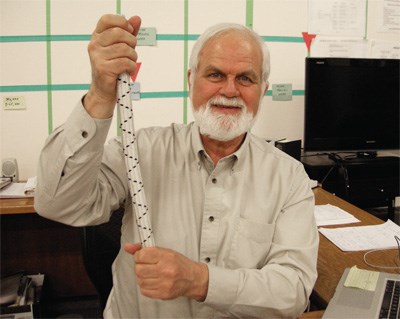A synthetic rope used by the U.S. Navy for mooring aircraft carriers is one step closer to being proven a viable alternative to wire rope in underground mining applications after passing a coilability test late last year.
“There’s no doubt in anyone’s mind that it has the strength to do the job,” said Charles Graham, managing director of CAMIRO’s mining division. “The question is, does it have the other properties that we expect from a hoist rope.”
Wire rope coils perfectly on a drum, explained Graham. “The first layer goes on, the second layer goes over top of that, and so on. Synthetic rope has to do the exact same thing. If it’s not rigid enough across its diameter, one layer will run into the one below and when you try to unwind it, all you have is a mess of rope. It has to coil and it has to do it perfectly every time.”
The successful coilability test demonstrated that the synthetic rope spools on and off a drum “with no glitches, no hitches and no bunching up,” said Graham.
The test was carried out by Whitehill Manufacturing of Philadelphia, the company that makes the synthetic rope, under the supervision of Natural Resources Canada’s CANMET Mining and Mineral Sciences Laboratories.
Research on the use of synthetic rope is being funded by the CAMIRO-managed Deep Mining Research Consortium, which includes Vale, Xstrata, Agnico-Eagle, Barrick Gold and CANMET.
The much lighter synthetic rope, made of aramid fiber, a high-strength, heat resistant synthetic material similar to kevlar, would allow mines to operate at greater depths and hoist more ore.
“The regulations in Ontario say the rope capacity has to exceed the load on the bottom by a factor of five,” explained Graham. “This means that at around 2,300 metres, you get to the point where the only thing you can lift is the rope itself. If you lighten the rope, you could go much deeper.”
Switching to synthetic rope could cut hoisting costs in half at Agnico-Eagle’s La Ronde Mine in northwestern Quebec and at Xstrata Copper’s Kidd Mine in Timmins, said Graham.
However, much more testing has to be done before synthetic rope is deemed safe.
The next step will be to run a lab test at speed and full tension, “and run it long enough to determine how it will fail,” said Graham.
“With wire rope, we have non-destructive testing that we subject the rope to in order to determine if it’s worn, corroded, or if there are broken wires. We have the technology to tell us that if it’s a steel rope. We don’t know what we would do to figure these things out in a synthetic rope.”
The consortium also looked at the possibility of developing a hybrid rope using the aramid fiber as the core and wrapping steel around it. The hybrid product would allow for conventional non-destructive testing, but would provide only 20 per cent of the benefit of purely synthetic rope because of the additional weight.
“We went far enough to figure out what the hybrid rope would look like, who would make it and where we would test it,” said Graham. A live three-year test was planned for Podolsky Mine in Sudbury, but scrapped when Quadra FNX, now KGHM, decided to put the mine on care and maintenance.
The German manufacturer of the hybrid rope carried out a test on a koepe hoist in Australia, but the rope didn’t perform as expected and went back to Germany for further work. A test using a double drum hoist could produce different results, but a new test site would have to be found, said Graham.
Additional testing of the 100 per cent synthetic product will cost upwards of $1 million, but may be outside the mandate of the Deep Mining Research Consortium, which is currently scheduled to cease operations in December 2013.
“The success of the coilability test has opened the door to a whole bunch more work, but it will have to be done outside of the DMRC because of the dollars required to do it and the amount of time it will take to get it done,” said Graham.
There is still a possibility that the DMRC will decide to extend its mandate, but if not, new funding partners will be invited to carry on the work.
Other research carried out by the DMRC has focused on diesel engine performance at depth, heat stress, automatic hoist rope inspection and ground support.



